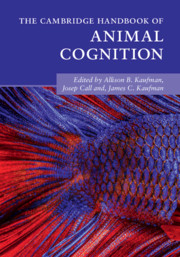Book contents
- The Cambridge Handbook of Animal Cognition
- The Cambridge Handbook of Animal Cognition
- Copyright page
- Dedication
- Contents
- Figures, Tables, and Boxes
- Contributors
- Acknowledgments
- Introduction
- Part I Communication and Language
- Part II Memory and Recall
- Part III Social Cognition
- Part IV Social Learning and Teaching
- 19 Social Learning and Teaching Overview
- 20 Tandem Running Recruitment by Temnothorax Ants as a Model System for Social Learning
- 21 Fish Social Networks
- 22 Social Learning in Birds
- 23 Social Learning in Chimpanzees
- Part V Numerical and Quantitative Abilities
- Part VI Innovation and Problem-Solving
- Index
- References
23 - Social Learning in Chimpanzees
from Part IV - Social Learning and Teaching
Published online by Cambridge University Press: 01 July 2021
- The Cambridge Handbook of Animal Cognition
- The Cambridge Handbook of Animal Cognition
- Copyright page
- Dedication
- Contents
- Figures, Tables, and Boxes
- Contributors
- Acknowledgments
- Introduction
- Part I Communication and Language
- Part II Memory and Recall
- Part III Social Cognition
- Part IV Social Learning and Teaching
- 19 Social Learning and Teaching Overview
- 20 Tandem Running Recruitment by Temnothorax Ants as a Model System for Social Learning
- 21 Fish Social Networks
- 22 Social Learning in Birds
- 23 Social Learning in Chimpanzees
- Part V Numerical and Quantitative Abilities
- Part VI Innovation and Problem-Solving
- Index
- References
Summary
Social learning, a type of information transmission in which individuals gain information by observing or interacting with another animal or the products of another animal’s actions, is an extensively studied subject in a wide array of species. Of particular interest is the ability of chimpanzees (Pan troglodytes) to learn socially, especially given their extensive sociality and fission–fusion dynamics, which provides many opportunities for individuals to learn from each other in different contexts. Using observational and experimental approaches, researchers have explored how faithfully chimpanzees copy others, the type of information conveyed between individuals, and the extent to which social learning is influenced by external factors. In this chapter we review what is currently known about the mechanisms by which chimpanzees socially learn and the strategies they may employ when doing so. We also discuss the much-debated topic of chimpanzee "culture," and how this compares to our own culture. Last, we provide a comparative perspective for social learning in chimpanzees with other species, and discuss how understanding chimpanzee social learning can be useful in their captive care and aiding their conservation in the wild.
- Type
- Chapter
- Information
- The Cambridge Handbook of Animal Cognition , pp. 534 - 558Publisher: Cambridge University PressPrint publication year: 2021



